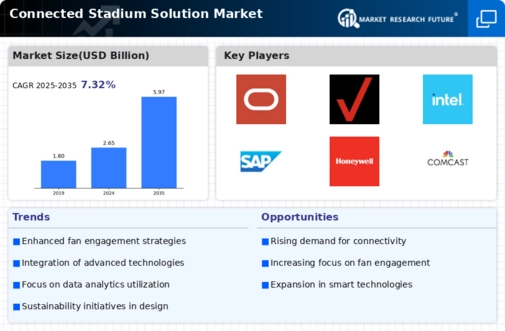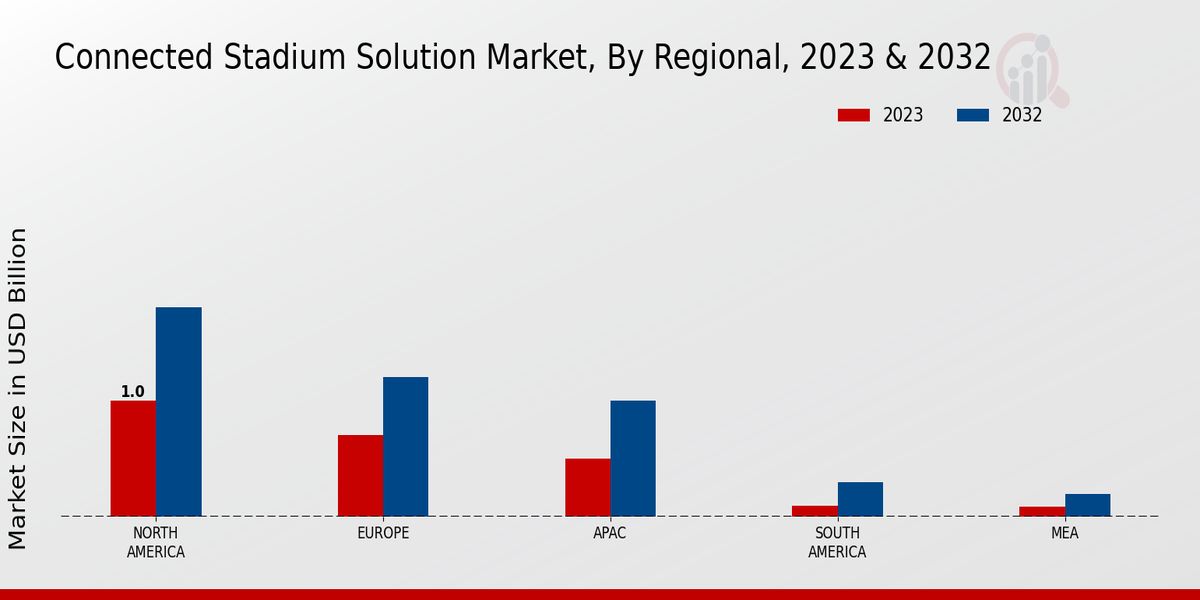Market Growth Projections
The Global Connected Stadium Solution Market Industry is poised for substantial growth, with projections indicating a market value of 2.65 USD Billion in 2024 and an anticipated increase to 5.97 USD Billion by 2035. This growth reflects a compound annual growth rate (CAGR) of 7.66% from 2025 to 2035. The increasing adoption of connected technologies, coupled with rising consumer expectations for enhanced experiences, is driving this upward trajectory. As stadiums continue to invest in innovative solutions, the market is likely to witness significant advancements, reshaping the landscape of sports and entertainment venues.
Growing Adoption of Data Analytics
The utilization of data analytics is transforming the Global Connected Stadium Solution Market Industry. Stadiums are increasingly leveraging data to understand fan behavior, optimize operations, and enhance security measures. By analyzing ticket sales, concession purchases, and crowd movements, stadium operators can make informed decisions that improve the overall experience. This data-driven approach not only boosts efficiency but also fosters loyalty among fans. As the market continues to evolve, the integration of advanced analytics tools is expected to play a crucial role in shaping the future of stadium operations.
Rising Demand for Enhanced Fan Experience
The Global Connected Stadium Solution Market Industry is witnessing a surge in demand for enhanced fan experiences. Stadiums are increasingly adopting connected technologies to provide real-time information, seamless connectivity, and personalized services. For instance, the integration of mobile applications allows fans to access live statistics, order food, and navigate the venue efficiently. This trend is expected to drive the market's growth, with projections indicating a market value of 2.65 USD Billion in 2024. As fan expectations evolve, stadiums that leverage these technologies are likely to attract larger audiences, thereby enhancing revenue streams.
Technological Advancements in Connectivity
Technological advancements in connectivity are significantly influencing the Global Connected Stadium Solution Market Industry. The deployment of 5G networks and enhanced Wi-Fi solutions is enabling faster and more reliable internet access within stadiums. This connectivity allows for real-time engagement through social media, live streaming, and interactive applications. As fans increasingly rely on their devices for information and entertainment, stadiums that provide robust connectivity are likely to see increased attendance and engagement. The ongoing advancements in connectivity technologies are anticipated to propel the market forward, aligning with the projected CAGR of 7.66% from 2025 to 2035.
Increased Investment in Smart Infrastructure
Investment in smart infrastructure is a pivotal driver for the Global Connected Stadium Solution Market Industry. Governments and private entities are allocating substantial funds to modernize stadium facilities, integrating IoT devices, and enhancing connectivity. This modernization not only improves operational efficiency but also elevates the overall spectator experience. For example, smart lighting and energy management systems are being implemented to optimize resource usage. With a projected market growth to 5.97 USD Billion by 2035, the emphasis on smart infrastructure is likely to reshape how stadiums operate and engage with fans.
Focus on Sustainability and Eco-Friendly Solutions
Sustainability is becoming a central theme in the Global Connected Stadium Solution Market Industry. Stadiums are increasingly adopting eco-friendly solutions, such as energy-efficient systems and waste management technologies, to reduce their environmental impact. This focus on sustainability not only aligns with global environmental goals but also appeals to environmentally conscious fans. For instance, initiatives like solar energy installations and water conservation systems are being implemented to promote green practices. As the market evolves, the integration of sustainable technologies is expected to become a key differentiator for stadiums, enhancing their appeal and operational efficiency.













